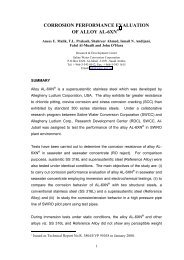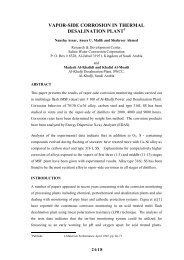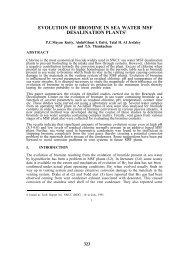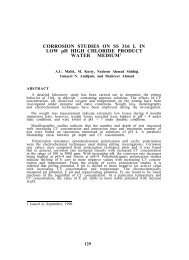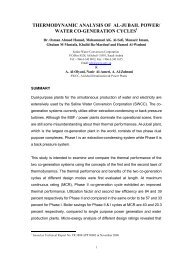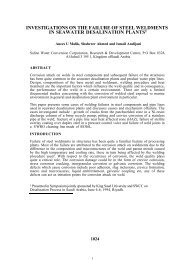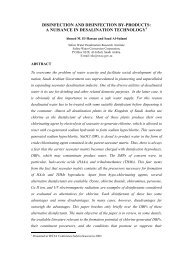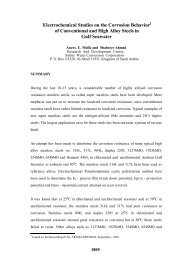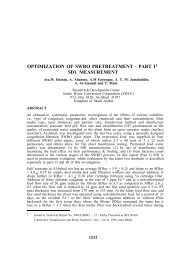impact of interruption of antiscalant dosing or cleaning balls ...
impact of interruption of antiscalant dosing or cleaning balls ...
impact of interruption of antiscalant dosing or cleaning balls ...
Create successful ePaper yourself
Turn your PDF publications into a flip-book with our unique Google optimized e-Paper software.
Direct comparison <strong>of</strong> Figures 5 and 6 show that the ball <strong>cleaning</strong> operation is highly<br />
needed and it is effective when phosphonate based <strong>antiscalant</strong> is used. This deduction<br />
is consistent with the findings rep<strong>or</strong>ted earlier by Al-Zahrani, et.al [6].<br />
To investigate further the <strong>impact</strong> <strong>of</strong> no-ball <strong>cleaning</strong> operation on the effectiveness <strong>of</strong><br />
phosphonate based <strong>antiscalant</strong>, two consecutive tests were carried out. The results are<br />
shown in Figure 7. In the first test, the pilot plant was operated at TBT <strong>of</strong> 100 o C<br />
without ball cycling and with a relatively high dose rate <strong>of</strong> phosphonate based<br />
<strong>antiscalant</strong>, that was 3 ppm. In a period <strong>of</strong> 130 hours the brine heater FF almost<br />
approached the design value. Ball <strong>cleaning</strong> cycling was resumed and the <strong>or</strong>iginal FF <strong>of</strong><br />
the unit was rest<strong>or</strong>ed. The test was then carried out with a lower dose rate <strong>of</strong> 1.0 ppm.<br />
It took around 200 hours – a period which was longer than that obtained with a dose<br />
rate <strong>of</strong> 3 ppm - to reach the targeted FF. The threshold inhibition <strong>of</strong> the phosphonate<br />
based <strong>antiscalant</strong> with no ball <strong>cleaning</strong> at a dose rate <strong>of</strong> 1.0 ppm was thus m<strong>or</strong>e<br />
effective than that when using a relatively high dose rate <strong>of</strong> 3.0 ppm. Over-<strong>dosing</strong> <strong>of</strong><br />
the phosphonate based <strong>antiscalant</strong> with no ball <strong>cleaning</strong> was responsible f<strong>or</strong> f<strong>or</strong>mation<br />
<strong>of</strong> excessive sludge. The maj<strong>or</strong>ity <strong>of</strong> SWCC’s MSF plants as described in Section 1.2<br />
prefer to increase <strong>antiscalant</strong> dose to counter the negative <strong>impact</strong> <strong>of</strong> <strong>interruption</strong> <strong>of</strong><br />
<strong>cleaning</strong> <strong>balls</strong> circulation.<br />
Based on the preliminary tests, which were carried out in the MSF pilot plant, it is<br />
recommended that plants which are using phosphonate based <strong>antiscalant</strong> have to<br />
review the remedial actions, which they follow in case <strong>of</strong> <strong>interruption</strong> <strong>of</strong> ball<br />
circulation.<br />
3.2 Commercial Plant Test<br />
An evaluation test was conducted in unit # 8 <strong>of</strong> Al-Khobar Phase-II MSF plant to<br />
expl<strong>or</strong>e the consequences when <strong>antiscalant</strong> <strong>dosing</strong> was suddenly interrupted and<br />
stopped completely. The evaluation test was carried out on Monday 28 th July, 2004. At<br />
7.10 a.m. the <strong>antiscalant</strong> <strong>dosing</strong> was completely stopped and n<strong>or</strong>mal ball <strong>cleaning</strong><br />
operation was maintained throughout the whole test period. Comprehensive chemical<br />
analyses were carried out <strong>of</strong> the most imp<strong>or</strong>tant liquid streams which included:<br />
• Seawater make-up



